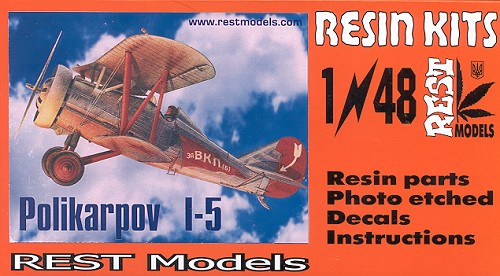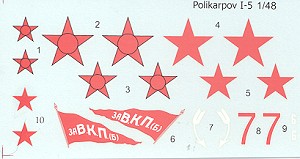
| KIT: | Rest 1/48 Polikarpov I-5 |
| KIT #: | RM 4805 |
| PRICE: | $58.00 from DMC Models |
| DECALS: | Three options |
| REVIEWER: | Scott Van Aken |
| NOTES: | Resin kit with etched fret and metal parts. |

| HISTORY |
The Polikarpov I-5 was a standard, conventional biplane like the US P-12 or the British Bulldog. Like the British aircraft, it was powered by a Jupiter radial engine which the Soviets had built under license as the M-22. Thanks to its light construction, the I-5 was faster than its contemporaries. What makes this even more amazing is that Polikarpov and his team had been arrested as it was thought that several crashes of his aircraft were due to sabotage. As a result it was felt they were counter-revolutionaries and had to be imprisoned.
As is not often realized, interned aircraft designers were still allowed to continue with their work. In fact, it was not uncommon for them to perform 14 hour days doing so. The aviation industry in the Soviet Union was often targeted for Stalin's fears and paranoia as Stalin was deathly afraid of flying and so blamed aircraft designers for that fear. The result of this is that nearly all the major aircraft designers spent some portion of their lives locked away.
It was under these conditions that the I-5 was created. Much to everyone's relief, it was a huge success with over 800 of the type being constructed. This led to the even more successful I-15 and derivatives. Due to these successes, Polikarpov and his team were released in the early 1930s and the start of the Polikarpov fighter dynasty was well under way.
| THE KIT |
 The first thing that struck me when opening the box were that there seem to be a lot of parts. Not only that, but I didn't see any parts on resin pour stubs as is so common with resin kits. REST has taken the bold step of designing their molds so that there either are not any stubs, or those that are extant are minimal in nature. This removes much of the tedium of building a resin kit, as I have to admit that cutting parts from stubs is my least favorite part of the process.
The first thing that struck me when opening the box were that there seem to be a lot of parts. Not only that, but I didn't see any parts on resin pour stubs as is so common with resin kits. REST has taken the bold step of designing their molds so that there either are not any stubs, or those that are extant are minimal in nature. This removes much of the tedium of building a resin kit, as I have to admit that cutting parts from stubs is my least favorite part of the process.
Next, you'll find that the fuselage is pretty much a single piece with a hollowed out cockpit section. The upper cowl is separate so that the interior can be detailed with the resin and photo etched parts provided. This means no nasty fuselage centerline seam to deal with; only a tiny pour stub on the bottom. The fin is part of the fuselage mold so that also eliminates a seam problem.
The upper wing is a single piece with separate ailerons. There are alternate wing struts provided. In resin there are what I'll call the thin and the thick N struts as well as the thinner N struts being done in cast metal (a great idea to keep the weight of the wing from deforming the struts). You also get two different landing gear struts; again, a thick and thin set with the thinner set also done in metal, which is more easily able to handle the weight.
The engine consists of a block and separate cylinders, each cylinder superbly molded and complete with exhaust stub. Much of the interior detail is done in photo-etch. An acetate instrument backing is provided for the p.e. panel and a card panel which you'd cut out and paste in place is also provided. The interior is quite well detailed and you basically make a cage out of the resin floor and p.e. sidewall detail, much the same way as is done with the Mirage PZL 11/24 kits.
Instructions are most unusual. One side of the sheet offers a n exploded view of the parts, including the placement of optional bits. There are also a number of smaller diagrams for sections of the kit such as the interior assembly and the upper cowl parts placement. Several additional drawings are given for alignment purposes. Two formers are also provided to help with the alignment of struts and the lower wing, a most appreciated addition.
 The other side of the sheet provides a set of cut-away plans and several photos of the real aircraft. Markings are provided for three planes. These are given on an additional color card that has a few more photos and a color chart given in Humbrol, ModelMaster and generic terms. One aircraft is the box art plane with the wider struts in aluminum with red trim. Actually a very colorful aircraft as the rudder, struts and landing gear area all in red. The other two are very generic in Russian Green Upper with Russian Blue undersides. The decal sheet provided is crisply printed and quite matte. They also appear to be very thin. I've no idea who printed them an so don't know how well they will work. Actual use will bring out that info. To my eyes, the red seems a bit, well, faded and not as strong as I might expect. This may well change when actually applied to the model.
The other side of the sheet provides a set of cut-away plans and several photos of the real aircraft. Markings are provided for three planes. These are given on an additional color card that has a few more photos and a color chart given in Humbrol, ModelMaster and generic terms. One aircraft is the box art plane with the wider struts in aluminum with red trim. Actually a very colorful aircraft as the rudder, struts and landing gear area all in red. The other two are very generic in Russian Green Upper with Russian Blue undersides. The decal sheet provided is crisply printed and quite matte. They also appear to be very thin. I've no idea who printed them an so don't know how well they will work. Actual use will bring out that info. To my eyes, the red seems a bit, well, faded and not as strong as I might expect. This may well change when actually applied to the model.
| CONCLUSIONS |
Overall, this looks like a very nice kit indeed. It is the type of kit that will appeal to those who like between the wars aircraft. The fact that most of the parts are pretty well ready to go should make this a pretty easy build as far as resin kits go. Just a tad bit of clean-up and construction can start right away. If you are already comfortable with biplanes and want to get into doing resin kits, then this one is for you!
Many thanks to DMC Models for the review kit.
If you would like your product reviewed fairly and fairly quickly by asite that has nearly 300,000 visitors a month, please contactme or see other details in the